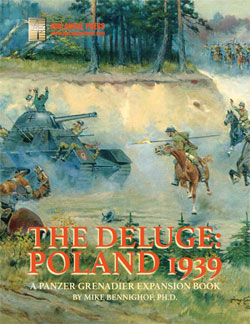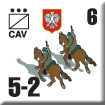| The Deluge:
Polish
Cavalry, 1939
By Mike Bennighof, PhD
June 2020
 Since the wars with the Turks in the 16th
and 17th centuries, Poland’s cavalry
has stood atop the country’s military
hierarchy. Even when there was no Poland,
Polish cavalry regiments added to their nation’s
military prestige in the Napoleonic Wars. Since the wars with the Turks in the 16th
and 17th centuries, Poland’s cavalry
has stood atop the country’s military
hierarchy. Even when there was no Poland,
Polish cavalry regiments added to their nation’s
military prestige in the Napoleonic Wars.
When Poland re-emerged from the chaos that followed
the First World War, her cavalrymen gained new
honors fighting the Soviets in the early 1920s.
Juliusz Rommel and his 1st Polish Cavalry Division
destroyed the Red “First Cavalry Army”
at the Battle of Komarow, ending the war in
a decisive Polish victory. Poland dictated peace
terms to the new-born but enormously larger
communist state, annexing a wide swath of territories.
In the years that followed, her cavalry regiments
remained the army’s most prestigious.

The Pride of Poland.
|
When the Germans attacked Poland in the late
summer of 1939, the Polish Army included 40
cavalry regiments, all of them regular army
units. Three of them had been motorized during
the late 1930s, but the other 37 remained
horsed — by way of comparison, the Polish
army only had 90 regular infantry regiments
(supplemented by reserve infantry regiments).
Polish cavalry received 58 million zloty in
the 1938-39 military budget, or 7.3 percent
of the total, compared to 46.3 million for
the entire Air Force (5.8 percent).
Based on Polish experience of their war with
the Soviets — and in the 1930s, this
represented the most recent combat lessons
of any army in Central or Eastern Europe —
the slant toward cavalry made good sense.
The Poles went to war in 1919 with but 110,000
men, eventually raising this number to 540,000.
Clearly, however, Poland could never match
the manpower resources of the Soviet Union
and could not match those of Germany unless
operating in alliance with France.

Polish cavalrymen in action, 1939.
|
Both the Russian Civil War and the Soviet-Polish
War showed that cavalry remained a viable
combat force. The mobility provided by horses
allowed troops to cover wide regions, without
being tied to transportation networks of roads,
railroads or rivers. Polish doctrine therefore
gave cavalry a defensive mission — the
cavalry would rush to threatened areas and
hold them until the infantry could counter-attack.
Wartime experience had also shown that cavalry
could not hope to match the firepower of infantry
formations, and so infantry divisions would
undertake offensive operations.
In 1939, the 37 regiments formed 11 brigades,
four of them each including four regiments
and the other seven with three each. When
Poland mobilized for war, each of the seven
field armies received one or two brigades;
they were not concentrated into higher-level
formations. Each army needed a cavalry contingent
to help counter German moves, the high command
believed, and every individual army commander
wanted cavalry under his command.

Mounted firepower: a Polish taczanka.
|
A Polish cavalryman went to war with a Karabinek
1898 carbine, a shortened version of the German-designed
Mauser M98 manufactured by the PMK arms factory
in Warsaw. The lance had been abolished in 1934
over strong objections of many traditionalists
in the army. When Poland secretly ordered mobilization
in August 1939, Polish cavalry regiments issued
lances anyway — on such a broad scale
that the move had to have official sanction,
though in the chaos of Poland’s collapse
no one would ever be held to account for the
order. A Polish cavalry lance was made of a
steel tube just under 10 feet long, with a wicked
four-bladed head. Just under the head came a
small pennant in the regiment’s colors.
Leather straps helped the lancer balance the
weapon.
A Polish cavalry regiment had four squadrons,
each of about 120 men, each in turn divided
into three troops. Each troop included an
anti-tank rifle and a light machine gun (a
Polish-made licensed copy of the American
Browning Automatic Rifle). The regiment also
had a machine gun squadron with a dozen heavy
machine guns — Polish-made wz.30 copies
of the excellent American Browning M1917 water-cooled
.30-caliber machine gun. After paying John
Browning for the BAR license, lawyers at the
Polish Ministry of War realized that the American
inventor had never registered his patents
in Poland and when he entered his weapon and
plans for it in the 1927 competition for a
standard machine gun, the Poles simply appropriated
it and made 8,000 of them without paying a
single zloty to Browning. Four of the weapons
were carried on light horse-drawn carts known
as “taczanka” for firing on the
move, the others on pack horses.

A myth that refuses to die; Polish cavalry
never charged German tanks in the 1939
campaign.
|
The regiment also included a section of four
anti-tank guns (37mm Bofors guns, built in
Poland under a Swedish license for which the
Poles actually paid), a small anti-aircraft
section with four machine guns on high-angle
mounts, and a platoon of cyclists.
A cavalry brigade had three or four such
regiments, plus a battalion-sized artillery
regiment with twelve 75mm field guns (16 of
them in a four-regiment brigade). The brigade
also had a small tank battalion with 13 tankettes
and eight armored cars, a truck-mounted rifle
battalion and two-gun sections of anti-tank
and anti-aircraft guns. Some brigades also
had a bicycle company. The organization totaled
just under 6,000 men on the three-regiment
pattern, just under 7,000 for those brigades
with four regiments.
Scattered along the Polish front when the
Germans invaded on 1 September 1939, the cavalry
brigades immediately became involved in heavy
fighting. Two brigades had been slotted for
daring attacks in the event of war with Germany
— the Podolska Brigade would ride straight
for Berlin, while the Pomorska Brigade captured
the free city of Danzig.

Poland is not yet lost.
|
Instead the Polish horsemen found themselves
facing overwhelming numbers and firepower. Some
brigades scored impressive tactical successes:
On the first day of the war, the Wolynska Brigade
destroyed 76 tanks and 74 other vehicles of
the 4th Panzer Division. The Pomorska Brigade
veered from its assigned assault on Danzig when
its staff realized that the German 20th Motorized
Division had blundered past them and exposed
their rear flank. The lancers mounted up and
rode down an entire German infantry battalion
before encountering German armored cars and
giving rise to the slander that Polish lancers
had stupidly attacked German tanks. The Suwalska
Brigade invaded East Prussia, but withdrew from
its untenable positions; the Wielkopolska Brigade
inflicted another defeat on the hard-luck 4th
Panzer at the Bzura River in mid-September.
 Thousands of cavalrymen slipped over the
Hungarian, Romanian and Lithuanian frontiers
following Poland’s collapse. One of
them, Brig. Gen. Wladyslaw Anders of the Nowogrodzka
Cavalry Brigade, would command the famous
Polish II Corps in the Italian Campaign after
his release from a Soviet prison. Thousands of cavalrymen slipped over the
Hungarian, Romanian and Lithuanian frontiers
following Poland’s collapse. One of
them, Brig. Gen. Wladyslaw Anders of the Nowogrodzka
Cavalry Brigade, would command the famous
Polish II Corps in the Italian Campaign after
his release from a Soviet prison.
Polish cavalrymen fought well in 1939, but
could not prevent their nation’s fall.
The Polish high command might have deployed
them better, but this would only have delayed
the inevitable. Spending more than four times
as much on the cavalry arm as on the Armored
Force in the years before the war was a much
greater miscalculation than any on the battlefield.
Don’t wait to put The Deluge on your game table! Join the Gold Club and find out how to get it before anyone else, at a better price than anyone else!
Sign up for our newsletter right here. Your info will never be sold or transferred; we'll just use it to update you on new games and new offers.
Mike Bennighof is president of Avalanche Press and holds a doctorate in history from Emory University. A Fulbright Scholar and NASA Journalist in Space finalist, he has published over 100 books, games and articles on historical subjects.
He lives in Birmingham, Alabama with his wife, three children and his dog, Leopold. Leopold approves of this message.
|
